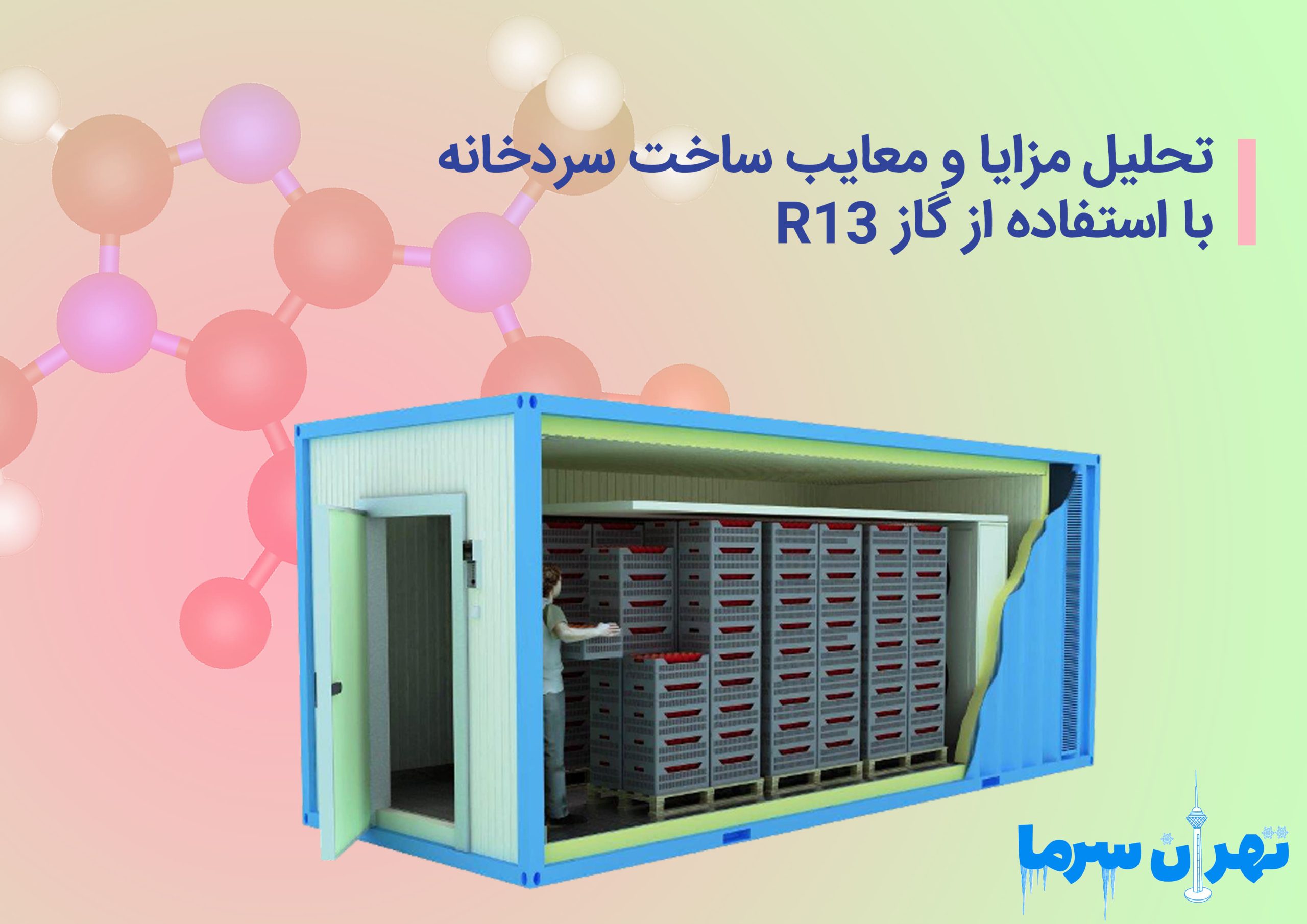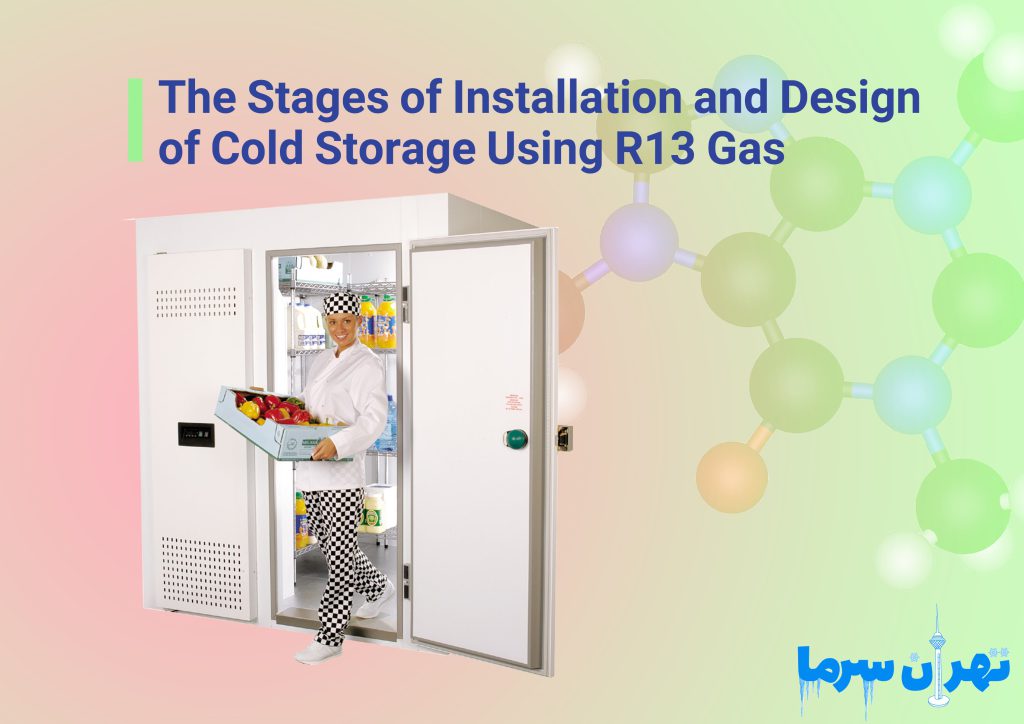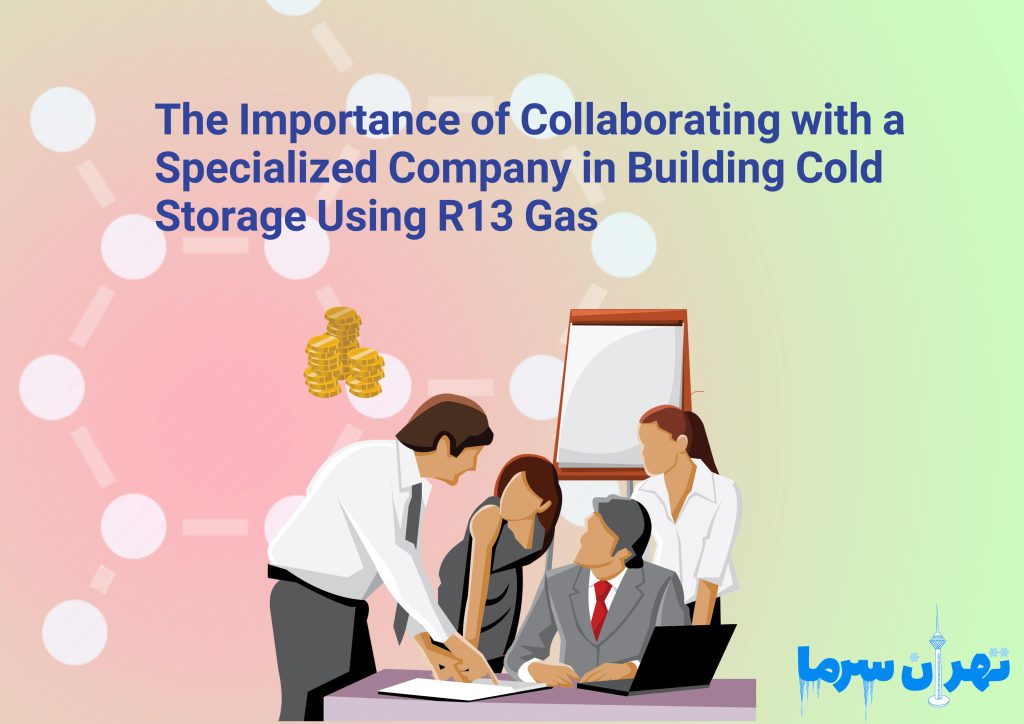Analysis of the Advantages and Disadvantages of Building Cold Storage Using R13 Gas

Building Cold Storage Using R13 Gas: Advantages, Disadvantages, and Design Process
Building cold storage using R13 gas is particularly popular due to its powerful cooling properties and high efficiency in refrigeration systems.
Installing and designing cold storage with R13 gas requires expertise and adherence to safety standards to ensure both optimal performance and the security of the system. Additionally, analyzing cold storage construction using R13 gas can play an important role in optimizing energy consumption.
Cold Storage with R13 Gas and Low-Temperature Capabilities One of the main advantages of using this gas in col storage is its ability to create very low temperatures. This feature is especially important for cold storage units designed to preserve temperature-sensitive materials such as pharmaceuticals, laboratory supplies, and certain food products.
This gas also has high chemical stability, which helps extend the lifespan of refrigeration equipment and reduces the need for frequent repairs. Moreover, R13 gas has specific thermal properties that enhance the efficiency of refrigeration units and optimize energy consumption at extremely low temperatures.
Cold Storage Installation and Design Using R13 Gas: Limitations Along with the significant benefits, using this gas has some disadvantages and limitations. One of the main challenges is its environmental impact. R13 gas is considered an ozone-depleting substance and has a considerable effect on global warming.
As a result, the use of this gas is regulated in many countries. The high cost of sourcing and maintaining R13 gas is another disadvantage. Additionally, installing and designing refrigeration systems with R13 gas requires specialized knowledge and equipment, which can increase the initial cost of building cold storage.
Safety issues are also an important aspect when analyzing the construction of cold storage using R13 gas. Due to its chemical properties, R13 gas can pose health and financial risks if leaked. Therefore, adherence to safety standards in the design and maintenance of cold storage facilities using this gas is essential.
Analysis of Cold Storage Construction Using R13 Gas Ultimately, the decision to use R13 gas in cold storage construction should be based on the specific needs of the project, environmental regulations, and operational costs.
While this gas is an ideal choice for some industries due to its superior cooling capabilities, the associated challenges require thorough evaluation and the implementation of necessary measures to achieve a balance between efficiency, cost, and environmental protection.
Steps in Installing and Designing Cold Storage Using R13 Gas
Installing and designing cold storage using R13 gas is a specialized, multi-step process requiring technical knowledge, modern equipment, and adherence to safety standards. Due to its unique properties, such as the ability to create very low temperatures, this gas is used in specific industries like pharmaceuticals, laboratories, and storage of temperature-sensitive products.
Given its chemical properties, R13 gas requires careful planning in the design and implementation of refrigeration systems to ensure optimal performance and safety.
The first step in the cold storage construction process with R13 gas is evaluating the project’s needs and defining its goals. At this stage, it is determined what types of products the cold storage will hold and what temperature and environmental conditions need to be maintained.
This initial analysis helps in selecting the right equipment and designing the refrigeration system. Additionally, the cold storage capacity and space required for product storage need to be determined to ensure optimal performance.
The next step is designing the refrigeration unit, which includes selecting key components such as the compressor, evaporator, condenser, and piping. For refrigeration systems using this gas, equipment must be chosen to operate at extremely low temperatures.
Additionally, pipes and connections must be made from materials that can withstand low temperatures and pressure. This stage requires great care, as even a small error in design can reduce system efficiency or increase operational costs.
After completing the design, the installation of equipment begins. This involves placing the compressor, evaporator, and condenser in their designated locations and connecting them through piping.
Installation must follow safety standards and the design plans. Also, the R13 gas tanks and related charging equipment must be considered at this stage. Using precise equipment to measure pressure and temperature in these systems is crucial to ensure proper and efficient performance.
One of the most important parts of the installation process is charging the system with R13 gas. This process must be carried out by trained technicians since R13 gas requires careful handling due to its environmental and safety impacts. Overcharging or undercharging can reduce the system’s efficiency or even damage the equipment.
After the installation is complete, testing and commissioning of the cold storage take place. In this stage, the performance of all components is checked, and the system is briefly run under operational conditions to ensure its proper functioning. These tests include checking for gas leaks, compressor performance, pressure and temperature balance, and overall system efficiency. Any identified issues must be resolved before the system becomes operational.
New Technologies in Cold Storage Construction Using R13 Gas
One of the new technologies in cold storage construction using R13 gas is the implementation of smart control systems. These systems, equipped with advanced sensors and energy management software, allow operators to control the cold storage’s performance in real time.
Temperature and pressure sensors are installed at various points within the cold storage, providing accurate information about the system’s status. By analyzing this data, the system can automatically adjust to optimal conditions, preventing excessive energy consumption and maximizing efficiency.
Advanced insulating materials are another recent innovation that has had a significant impact on cold storage construction using R13 gas. The use of low thermal conductivity insulating materials, such as next-generation polymer foams, reduces heat loss and, as a result, decreases the energy required to maintain low temperatures. These materials not only improve the performance of the cold storage but also contribute to reducing operational costs.
In the equipment sector, modern, high-efficiency compressors have revolutionized refrigeration systems. These compressors, specifically designed to work with R13 gas, feature advanced motors and friction-reduction technologies. The outcome of this design is reduced energy consumption and extended compressor lifespan.
Additionally, some of these compressors are equipped with electronic control systems that allow for precise performance adjustments.
Leakage-reducing devices are another key advancement in this field. Given the environmental impact of R13 gas, technologies have been developed to prevent gas leakage. These devices include advanced seals and connections that prevent the gas from escaping the system. Moreover, high-sensitivity gas leak detection systems enable operators to quickly identify and address any issues.
One notable progress is the use of hybrid energy technologies in cold storage systems. These systems are designed to use renewable energy sources like solar and wind to supplement the cold storage’s energy needs. Combining these energy sources with R13 gas refrigeration systems can significantly reduce energy costs and enhance environmental sustainability.
Important Maintenance Tips for Cold Storage Using R13 Gas
Maintenance after the construction of cold storage using R13 gas requires special attention to several key factors to ensure optimal performance and system safety. One of the most important aspects is regular checks to prevent gas leaks, as R13 gas not only has a high cost but also poses significant environmental risks.
Additionally, periodic cleaning and servicing of main components such as the compressor, evaporator, and condenser are essential for increasing efficiency and reducing energy consumption. Adjusting the system’s pressure and temperature according to specified standards, as well as conducting routine tests to ensure proper operation, are also critical.
Furthermore, documenting all maintenance activities can help identify potential problems and prevent costly breakdowns.
The Importance of Partnering with a Specialist Company for Cold Storage Using R13 Gas
Collaborating with a specialist company in cold storage construction using R13 gas is crucial, as this gas requires precise design and implementation of refrigeration systems due to its unique properties.
Specialized companies, equipped with up-to-date technical knowledge and sufficient experience, can select the appropriate equipment and ensure compliance with safety and environmental standards. These companies can also leverage advanced technologies to increase energy efficiency and reduce operational costs.
Moreover, providing after-sales services and professional maintenance from these companies can extend the lifespan of the cold storage and prevent costly malfunctions.
?Why Choose Tehran Sarma Engineering for Building Cold Storage Using R13 Gas
For installing and designing cold storage using R13 gas, choosing Tehran Sarma Engineering is a smart decision. With years of experience and expertise in designing and constructing advanced refrigeration systems, this company offers optimal and efficient solutions.
Tehran Sarma, utilizing the latest technologies and a skilled engineering team, is capable of building cold storage systems with excellent performance while adhering to safety and environmental standards. The company also provides comprehensive support in consulting, design, installation, and after-sales services, ensuring customers’ confidence in the quality and durability of the cold storage units.
By choosing Tehran Sarma, you can easily benefit from the company’s professional expertise and full-range services, enabling you to build an efficient and cost-effective cold storage system. For more information about cold storage construction prices, you can visit Tehran Sarma’s website or contact them at 09121906418 and 02177972256.
Building cold storage with R13 gas, due to its ability to achieve very low temperatures, has widespread applications across various industries. The installation and design of cold storage with R13 gas should be carried out in such a way that, in addition to high efficiency, gas leakage and environmental issues are prevented.
Analyzing the construction of cold storage using R13 gas can also significantly impact the system’s performance and reduce energy costs.
Source:




 سردخانه
سردخانه برق
برق کمپرسور
کمپرسور کمپرسور بیتزر
کمپرسور بیتزر کمپرسور کوپلند
کمپرسور کوپلند کمپرسور بوک
کمپرسور بوک کمپرسور دانفوس
کمپرسور دانفوس کمپرسور منیروپ دانفوس
کمپرسور منیروپ دانفوس کمپرسور امبراکو
کمپرسور امبراکو کمپرسور پاناسونیک
کمپرسور پاناسونیک کمپرسور سابکول
کمپرسور سابکول کمپرسور کوپلند
کمپرسور کوپلند کمپرسور اسکرال کوپلند
کمپرسور اسکرال کوپلند کمپرسورفراسکلد
کمپرسورفراسکلد کمپرسور رفکامپ
کمپرسور رفکامپ کمپرسور اسکرال دانفوس
کمپرسور اسکرال دانفوس گاز مبرد
گاز مبرد گاز R22
گاز R22 گاز R134
گاز R134 گاز R404
گاز R404 گاز R407
گاز R407 گاز R410
گاز R410 گاز R508
گاز R508 کندانسور هوایی
کندانسور هوایی اواپراتور
اواپراتور اواپراتور آرشه
اواپراتور آرشه اواپراتور صابکول
اواپراتور صابکول اواپراتور آسه
اواپراتور آسه اواپراتور نیک
اواپراتور نیک اواپراتور آرتک
اواپراتور آرتک اواپراتور نوین
اواپراتور نوین اواپراتور تبادل کار
اواپراتور تبادل کار درب
درب ساندویچ پنل
ساندویچ پنل فن سردخانه
فن سردخانه روغن کمپرسور سانیسو
روغن کمپرسور سانیسو متعلقات سردخانه
متعلقات سردخانه